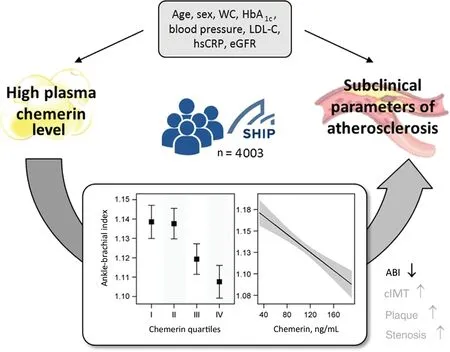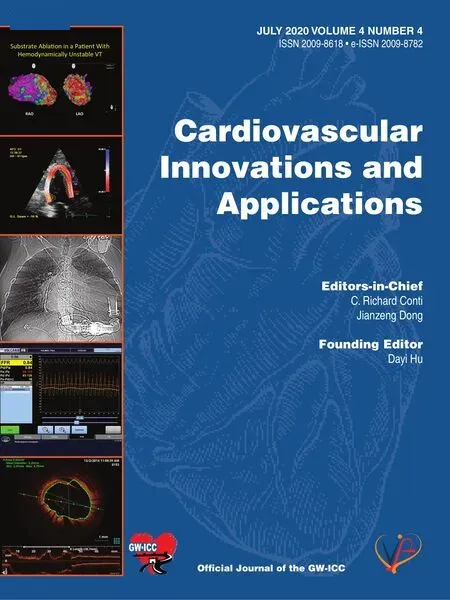Association of Serum Chemerin Levels with Coronary Artery Disease:Pathogenesis and Clinical Research
Assoc.Prof.Lutfu Askin,MD ,Assist.Prof.Hakan Duman,MD ,Ali Ozy ? ld ? z,MD and Okan Tanriverdi,MD
1 Department of Cardiology,Adiyaman Education and Research Hospital,Adiyaman,Turkey
2 Department of Cardiology,Faculty of Medicine,Recep Tayyip Erdogan University,Rize,Turkey
Abstract
Keywords:atherosclerosis;chemerin;heart failure;coronary artery disease;inflammation;metabolic syndrome
Introduction
The World Health Organization classifies cardiovascular diseases (CVD) as illnesses that are increasingly prevalent in the 21stcentury.CVD are characterized by high mortality,high morbidity,and low quality of life.The incidence of coronary artery disease (CAD) has increased in recent years.Studies have shown that CVD is responsible for 80% of deaths in low- and middle-income countries [1,2].
Chemerin plays an essential role in the development of CVD.Autopsy studies found a strong correlation between the secretion of chemerin in peripheral tissues and atherosclerosis.Chemerin is associated with the number of noncalcified plaques in patients with stable angina pectoris or peripheral artery disease.Case-control studies reported a relationship between CAD and serum chemerin levels.Echocardiographic studies found an association between CAD and epicardial adipose tissue,which is the primary source of chemerin secretion [3- 5].Therefore,chemerin may play a role in determining the severity of coronary lesions.This review suggests that chemerin may be a promising marker in CVD and an independent predictor of cardiovascular events.
Serum Chemerin Level as a New Indicator in Heart Failure
Chronic heart failure (CHF),a complex clinical syndrome characterized by ventricular remodeling,cardiac dysfunction,and hemodynamic abnormality,is the end-stage manifestation of various CVD.Many biomarkers have been identified and associated with the diagnosis and prognosis of CHF.These biomarkers may facilitate risk classification and treatment in CHF patients [6].
Chemerin is a recently discovered adipokine that is capable of regulating adipocyte differentiation and stimulating the chemotaxis of dendritic cells and macrophages.Increasing evidence has shown the association of chemerin with inflammation,obesity,metabolic syndrome,and CAD.Leiherer et al.[7]showed that high chemerin levels were associated with renal dysfunction and predicted cardiovascular events in patients with stable CAD.
Chemerin is an immune system regulator that works with chemokine-like receptor 1 (CMKLR1) and plays critical roles in metabolic and inflammatory processes [8].Gao et al.[9]found that chemerin messenger RNA and the protein were expressed in epicardial adipose tissue of patients with CAD and that the severity of coronary atherosclerosis was associated with chemerin expression.Rodr í guez-Penas et al.[10]reported that chemerin,regulated by cardiac metabolic and inflammatory mediators,might induce apoptosis and inhibit protein kinase B phosphorylation in cardiomyocytes.Besides,chemerin promotes adhesion of macrophages to vascular cell adhesion molecule 1 (VCAM-1) and fibronectin by aggregation of VLA-4 (also known as integrin α 4 β 1) and VLA-5 (also known as integrin α 5 β 1),contributing to inflammation [11].Inflammation plays an active role in the development of CVD,including hypertension,CAD,and CHF.Therefore,chemerin is involved in the pathogenesis of CVD through inflammatory mechanisms [12,13].
Xiaotao et al.[14]showed that high chemerin levels correlated with CAD and could reflect the severity of coronary atherosclerosis.Zhang et al.[15]reported increased plasma chemerin levels in patients with dilated cardiomyopathy.Also,chemerin was associated with an inflammatory response and left ventricular dysfunction.A recent study by Menzel et al.[16]showed a significant correlation between chemerin and CHF risk factors.
The Relationship between Chemerin Levels and RARRES2 Polymorphism in Coronary Artery Disease
T ? njes et al.[17],using a genome-wide metaanalysis,emphasized the role of genetic variants in controlling circulating chemical equilibrium.Two other genome-wide association studies showed no relationship betweenRARRES2genotypes and chemerin levels [7,18].
In a genome-wide association study performed in the Taiwan Biobank population study,promoter polymorphisms ofRARRES2correlated with chemerin levels [19,20].The study aimed to investigate the genetic basis of chemerin levels and to confirm the critical role of chemerin andRARRES2polymorphisms in the long-term outcomes of angiographically proven CAD patients.
Chemerin has been suggested as an indicator of cardiovascular risk [21].Serum chemerin may play a crucial role not only in the cause but also in the severity of CAD.Increased levels of chemerin in patients with CAD suggest that chemerin may be a new marker of coronary atherosclerosis and may play an essential role in CAD development ( Figure1) [16,22].Gasbarino et al.[23]demonstrated a relationship between chemerin and carotid plaque instability.Leiherer et al.[7]found that increased plasma chemerin level correlated with renal failure and was predictive of cardiovascular events in CAD patients.
Serum Chemerin Levels and Acute Coronary Syndrome
Kostopoulos et al.[24]claimed that in situ expression of chemerin and CMKLR1 in the human aorta and coronary arteries correlated with the severity of atherosclerotic lesions.Local expression of chemerin that interacts with CMKLR1 may contribute to atheromatous plaque progression by triggering complex cell-cell interactions.Chemerin and CMKLR1 seem to play an essential role in vascular inflammation and atherogenesis.Local chemerin production by several components of the vascular wall may have a distinctive effect depending on local interactions,because of proximity to lesions.Further research will explain the role of chemerin signaling in atherosclerosis [24].

Figure1:High plasma chemerin level and the development of coronary artery disease.
A recent prospective cohort study showed an association between chemerin levels and the severity of myocardial infarction,regardless of risk factors [25].Chemerin,as a chemokine and an adipokine,plays a vital role in the pathophysiology of CAD,involving multiple metabolic and immune-inflammatory mechanisms.Chemerin is involved in the activation of immune cells and migrates to endothelial cell damage sites [26].Chemerin receptors are present in the endothelium of the blood vessels and the underlying smooth muscle layers [26].Damage can expose chemerin receptors in endothelial smooth muscle cells and cause atherosclerosis [27].
Ji et al.[27]found that chemerin levels increased in acute coronary syndrome (ACS) but did not change in stable angina.This finding suggests that chemerin may serve as a new biomarker in ACS.However,in this study,long-term follow-up of ACS patients as required to evaluate the short-term and long-term significance of chemerin levels was not performed.
Chemerin induces the production of the adhesion molecules intercellular adhesion molecule 1 (ICAM-1) and E-selectin,and interacts with endothelium by promoting blood vessel remodeling and release of matrix metalloproteinases in vitro experiments [28].Chemerin’ s ability to regulate matrix metalloproteinases and other growth factors may play a role in the formation and progression of thromboembolism.Chemerin activates apoptosis in cardiomyocytes in a dose-dependent manner.This activation plays a role in the pathophysiology of CVD,such as acute myocardial infarction and CHF [10].Chemerin also plays an essential role in metabolic disorders [29].Chemerin affects lipid and glucose metabolism possibly changes inflammatory infiltration into the endothelium,which contributes to the pathogenesis of CAD [30].
In contrast,Aronis et al.[31]demonstrated no association of chemerin levels with ACS.Although there is evidence that chemerin may have some detrimental effects on vascular homeostasis and may be associated with the development of coronary atherosclerosis,they argued that studies showing a causal relationship between chemerin levels and CAD were lacking.Prospective studies are needed to evaluate the incidence of stable CAD and ACS in high-risk individuals with different baseline levels of chemerin [31].
Serum Chemerin Levels and Other Cardiac Conditions
Kammerer et al.[32]observed increased chemerin levels in patients with severe carotid artery stenosis and CAD.In the same study,systemic inflammation parameters were associated with cerebrovascular symptoms.Zhang et al.[33]showed the association of serum chemerin concentration with atrial fibrillation.Besides,chemerin levels were associated with atrial remodeling assessed by left atrial size.Lachine et al.[34]suggested that serum chemerin and high-sensitivity C-reactive protein may be considered as markers of subclinical atherosclerosis;therefore,they might be used for early detection of macrovascular disease in type 2 diabetes.Chemerin activates macrophage adhesion to fibronectin and VCAM-1.The secretion of chemerin by perivascular adipose tissue may cause contraction of vascular smooth muscle cells and plays a role in the development of hypertension [26].
Serum Chemerin Levels and Metabolic Syndrome
Herov á et al.[35]showed a relation between plasma chemerin levels and systemic inflammation markers and metabolic syndrome.In addition,they showed that low-dose aspirin treatment reduced proinflammatory cytokine secretion by macrophages,which might lead to reduced secretion of chemerin by adipocytes,and that aspirin could be a cause of low chemerin levels in CAD patients.
Several studies showed that the current chemical balance was associated with various cardiometabolic parameters and the severity of atherosclerosis [16].Yan et al.[36]showed a relation between high chemerin levels with an increased risk of CAD and the severity of atherosclerosis,independent of other cardiovascular risk factors.Besides,serum chemerin levels were associated with lipid profile,insulin resistance,and metabolic syndrome.These results suggest that chemerin may be a new link between metabolic signals and atherosclerosis.Further studies are needed to confirm current findings and to determine whether chemerin is a predictor of overt or silent CAD.
Conclusion
Adipokines have a role as regulators of appetite and energy homeostasis through the endocrine/systemic effect in the brain.Circulating adipokine levels vary depending on adipocytes.Therefore,they contribute to metabolic changes such as metabolic syndrome.As an inf lammatory adipokine,chemerin has been identif ied as a new indicator in the development of ACS and CHF.Chemerin might provide an alternative diagnostic tool for ensuring optimal treatment of patients with CAD.
Conflict of Interest
The authors declare that they have no conflicts of interest regarding the publication of this article.The founding sponsors had no role in the design of the study,in the collection,analyses,or interpretation of data,in the writing of the manuscript,or in the decision to publish the results.
 Cardiovascular Innovations and Applications2020年2期
Cardiovascular Innovations and Applications2020年2期
- Cardiovascular Innovations and Applications的其它文章
- The Accumulation of Visceral Fat and Preventive Measures among the Elderly
- Development of Primary Percutaneous Coronary Intervention as a National Reperfusion Strategy for Patients with ST-Elevation Myocardial Infarction and Assessment of Its Use in Egypt
- Discovery of Digenic Mutation,KCNH2 c.1898A > C and JUP c.916dupA,in a Chinese Family with Long QT Syndrome via Whole-Exome Sequencing
- Identification of Novel TTN Mutations in Three Chinese Familial Dilated Cardiomyopathy Pedigrees by Whole Exome Sequencing
- Chronic Effusive Pericarditis and Chronic Constrictive Pericarditis
- Some Issues Related to STEMI and NSTEMI
